|
|
AGRICULTURE RELATED SOCIAL SAFETY-NET A RESPONSE TO GLOBAL FINANCIAL
CRISIS
Paper for: 14th Government Development Partner Coordination
Committee (GDCC), on 28 April, 2009- CDC, Phnom Penh, Cambodia
|
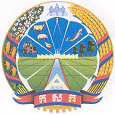 |
I- Overview of Agriculture Sector |
-
Cambodia is an agricultural country. 80% of
people living in rural areas and they rely on agriculture for their
livelihood;
-
Cambodia is rich in natural resources, including
agricultural land, forestry and fisheries that are favorable to
agricultural development;
-
Agriculture plays an important role for economic
growth, poverty reduction, social safety-net, particularly food
security as well as 70% of jobs for people;
|
 |
II- Strategic
Framework |
The long term visions and goals of the
strategies are to improve productivity and diversification of
agriculture, to ensure enough and safety food availability for all
people, to reduce poverty, increase GDP per capita and sustainable
natural resource management and conservation.
|
 |
III- Agriculture for Economic Growth and Poverty Reduction |
1. Agriculture Share in GDP:
In 2008, The global financial crisis has dropped down the share of
industry and services section in GDP, thereby increased the
agriculture share from 28.5% to 34.4%.
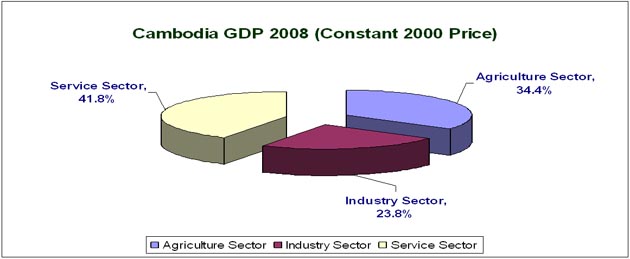
2. Evolution of Agriculture Growth (%)
1999-2008:
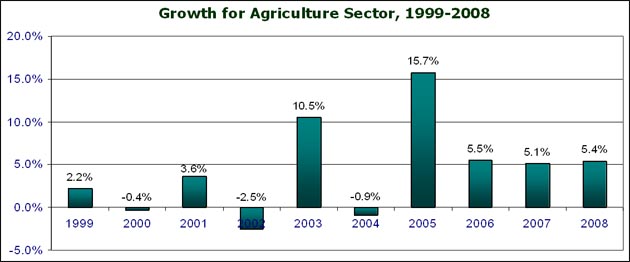

|
 |
IV- Food Availibity |
-
Rice symbolize the state of food security in Cambodia with 68% of
calories intake per capita;
-
Other non-rice food includes: subsidiary crops, livestock products,
fisheries products ect…
1- Rice Production:
|
Year
|
Cultivated
(ha) |
Yield
(T/ha) |
Production
(Tones Paddy) |
Surplus and Export |
|
1967-1968 |
2,513,800 |
1.00 |
2,513,800 |
Export
rice 252,000 T |
|
1999-2000 |
2,157,592 |
1.943 |
4,040,900 |
Export rice 260,710 T (407,359
tones paddy) |
|
2007-2008 |
2,585,905 |
2.620 |
6,727,127 |
Surplus exportable rice 1,649,640
T ( 2,577,562 tones paddy) |
|
2008-2009 |
2,615,741 |
2.746 |
7,175,473 |
Surplus rice 2 million tones
(3,16 tones paddy) |
2- Rice Balance 2008-2009
|
Description |
Unit |
Wet
season |
Dry
season |
Total |
|
Planning
|
Ha |
2,232,600 |
320,200 |
2,552,800 |
|
Cultivated
area |
Ha |
2,255,104 |
323,295 |
2,578,399 |
|
Destroyed
area |
Ha |
3,156 |
0 |
3,156 |
|
Replanting
area |
Ha |
785 |
|
785 |
|
Harvested
area |
Ha |
2,252,733 |
360,630 |
2,613,363 |
|
Yield |
T/Ha |
2.540 |
4.030 |
2.746 |
|
Production |
T |
5,722,142 |
1,453,331 |
7,175,473 |
Remark
- Reduction of 13 % for seed reserve and post
harvest losses
- Remaining paddy available for consumption
- Available rice for consumption converted into milled rice 64%
milling-rate
- Food requirement per year 143.0 kg x 13,778,115 (person)
- Surplus Production of rice 3,995,303 T - 1,970,270 T
- Surplus in term of Paddy |
932,811 t
6,242,662 t
3,995,303 t
1,970,270 t
2,025,033 t
3,164,114 t |
|
 |
3. Livestock Production |
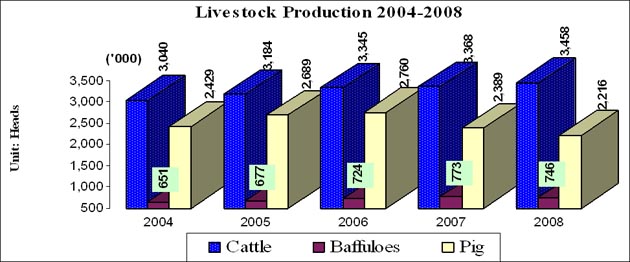
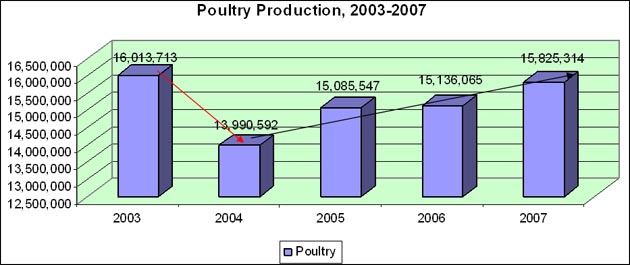
The Poultry development:
-
The poultry production decreased caused by bird
flu outbreak in
2004;
-
Since 2005, the poultry production considerably
increased from
15 million heads in 2005 to 16.9 million heads in 2008.
|
 |
4. Fisheries |
-
Inland Fisheries: Decreased from 395,000
mt (2007) to 365,000
mt, in 2008 due to change of natural water condition (the level of
water was lower than last year);
-
Marine Fisheries: Marine catches was
around 66,000 million
tones (2008), increased 18% within 5 years;
-
Aquaculture: Increased from 20,535 tones
to 40,000 tones;
-
Fisheries Community: 468 Fishery
Communities (227,044
members).

|
 |
V- Relevant on-going
Programmes/Projects for Poverty Reduction and Improving Food
Security |
Beside Government efforts to increase and
diversify production, there are a number of external funded projects
being implemented with specific purpose of reducing poverty and
improving food security among the poor and vulnerable groups.
Distribution of relevant on-going project by
agro-ecological regions:
|
 |
VI- Measures |
In response to the global financial crisis, the
following measures
should be undertaken:
-
Strongly implement the five programmes under
SAW, particular food security support programmes and other poverty
reduction and food security related projects.
The five programmes are:
(i)- Institutional capacity building and
management support program for
agriculture and water;
(ii)- Food Security Support Program;
(iii)- Agriculture and agri-business (Value Chain) support program;
(iv)- Water resource management, Irrigation, and land program;
(v)- Agricultural and water research, education and extension
program.
-
Implement Government initiatives of ”
Agricultural Fund ” to support agriculture;
-
Continue implementation of Government fiscal
policy on agricultural inputs, agricultural machinaries and
equipments; and strengthen monitoring on price of imported
fertilizer
-
Intensify and diversify food production by
smallholder farming households, particularly those that are food
income;
-
Accelerating access of smallholders to improve
technology, improve agricultural inputs, improve soil quality and
water management;
-
To further enhance agricultural productivity and
diversification at national level;
-
Increase public investment in physical
infrastructure including transportation, irrigation, market facility
in agricultural research and extension;
-
Strengthening community based organization;
-
Develop agro-processing and agri-business;
-
Develop micro credit.
|
|


